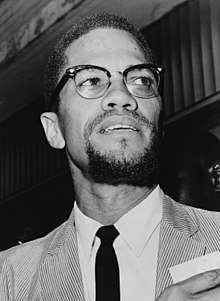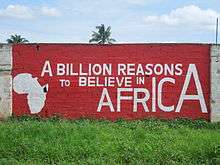Pan-Africanism
Pan-Africanism is a worldwide movement that aims to encourage and strengthen bonds of solidarity between all indigenous and diaspora ethnic groups of African descent. Based on a common goal dating back to the Atlantic slave trade, the movement extends beyond continental Africans with a substantial support base among the African diaspora in the Americas and Europe.[1][2]
| Part of the Politics series on |
| Pan-Africanism |
|---|
 |
|
People
|
|
Related |
|
| This article is part of a series about |
| Black Power |
|---|
 |
|
History |
|
Ideologies |
|
Organizations
|
|
Related |
|
Pan-Africanism can be said to have its origins in the struggles of the African people against enslavement and colonization[3] and this struggle may be traced back to the first resistance on slave ships—rebellions and suicides—through the constant plantation and colonial uprisings and the "Back to Africa" movements of the 19th century. Based on the belief that unity is vital to economic, social and political progress and aims to "unify and uplift" people of African descent.[4]
At its core, pan-Africanism is a belief that "African people, both on the continent and in the diaspora, share not merely a common history, but a common destiny".[5] Pan-Africanist intellectual, cultural and political movements tend to view all Africans and descendants of Africans as belonging to a single "race" and sharing cultural unity. Pan-Africanism posits a sense of a shared historical fate for Africans in America, West Indies and on the continent itself centered on the Atlantic trade in slaves, African slavery and European imperialism.[6]
The Organization of African Unity (now the African Union) was established in 1963 to safeguard the sovereignty and territorial integrity of its Member States and to promote global relations within the framework of the United Nations.[7] The African Union Commission has its seat in Addis Ababa and the Pan-African Parliament has its seat in Johannesburg and Midrand.[8]
Overview
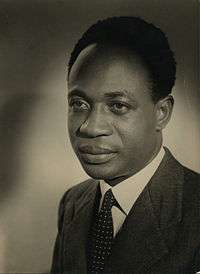
Pan-Africanism stresses the need for "collective self-reliance".[9] Pan-Africanism exists as a governmental and grassroots objective. Pan-African advocates include leaders such as Toussaint Louverture, Jean-Jacques Dessalines, Haile Selassie, Julius Nyerere, Ahmed Sékou Touré, Kwame Nkrumah, King Sobhuza II, Robert Mugabe, Thomas Sankara and Muammar Gaddafi, grassroots organizers such as Marcus Garvey and Malcolm X, academics such as W. E. B. Du Bois, Anténor Firmin and others in the diaspora.[10][11][12][13] Pan-Africanists believe that solidarity will enable the continent to fulfill its potential to independently provide for all its people. Crucially, an all-African alliance would empower African people globally.
The realization of the Pan-African objective would lead to "power consolidation in Africa", which "would compel a reallocation of global resources, as well as unleashing a fiercer psychological energy and political assertion...that would unsettle social and political (power) structures...in the Americas".[14]
Advocates of Pan-Africanism—i.e. "Pan-Africans" or "Pan-Africanists"—often champion socialist principles and tend to be opposed to external political and economic involvement on the continent. Critics accuse the ideology of homogenizing the experience of people of African descent. They also point to the difficulties of reconciling current divisions within countries on the continent and within communities in the diaspora.[14]
History
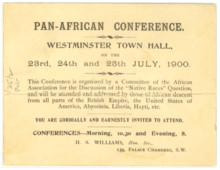
As a philosophy, Pan-Africanism represents the aggregation of the historical, cultural, spiritual, artistic, scientific, and philosophical legacies of Africans from past times to the present. Pan-Africanism as an ethical system traces its origins from ancient times, and promotes values that are the product of the African civilisations and the struggles against slavery, racism, colonialism, and neo-colonialism.[10]
Coinciding with numerous New World slave insurrections; highlighted by the Haitian Revolution, the end of the 19th century birthed an intercontinental pro-African political movement which sought to unify disparate campaigns in the goal to end oppression. Another important political form of a religious Pan-Africanist worldview appeared in the form of Ethiopianism.[15] In London, the Sons of Africa was a political group addressed by Quobna Ottobah Cugoano in the 1791 edition of his book Thoughts and Sentiments on the Evil of Slavery. The group addressed meetings and organised letter-writing campaigns, published campaigning material and visited parliament. They wrote to figures such as Granville Sharp, William Pitt and other members of the white abolition movement, as well as King George III and the Prince of Wales, the future George IV.
Modern Pan-Africanism began around the start of the 20th century. The African Association, later renamed the Pan-African Association, was established around 1897 by Henry Sylvester Williams, who organized the First Pan-African Conference in London in 1900.[16][17][18]
With the independence of Ghana in March 1957, Kwame Nkrumah was elected as the first Prime Minister and President of the State.[19] Nkrumah emerged as a major advocate for the unity of Independent Africa. The Ghanaian President embodied a political activist approach to pan-Africanism as he championed the "quest for regional integration of the whole of the African continent".[20] This period represented a "Golden Age of high pan-African ambitions"; the Continent had experienced revolution and decolonization from Western powers and the narrative of rebirth and solidarity had gained momentum within the pan-African movement.[20] Nkrumah’s pan-African principles intended for a union between the Independent African states upon a recognition of their commonality (i.e. suppression under imperialism). Pan-Africanism under Nkrumah evolved past the assumptions of a racially exclusive movement associated with black Africa, and adopted a political discourse of regional unity [21]
In April 1958, Nkrumah hosted the first All-African Peoples' Conference (AAPC) in Accra, Ghana. This Conference invited delegates of political movements and major political leaders. With the exception of South Africa, all Independent States of the Continent attended: Egypt, Ethiopia, Ghana, Liberia, Libya, Morocco, Tunisia and Sudan.[21] This Conference signified a monumental event in the pan-African movement, as it revealed a political and social union between those considered Arabic states and the black African regions. Further, the Conference espoused a common African Nationalist identity, among the States, of unity and anti-Imperialism. Frantz Fanon, journalist, freedom fighter and a member of the Algerian FLN party attended the conference as a delegate for Algeria.[22] Considering the armed struggle of the FLN against French colonial rule, the attendees of the Conference agreed to support the struggle of those States under colonial oppression. This encouraged the commitment of direct involvement in the "emancipation of the Continent; thus, a fight against colonial pressures on South Africa was declared and the full support of the FLN struggle in Algeria, against French colonial rule".[23] In the years following 1958, Accra Conference also marked the establishment of a new foreign policy of non-alignment as between the US and USSR, and the will to establish an "African Identity" in global affairs by advocating a unity between the African States on international relations. "This would be based on the Bandung Declaration, the Charter of the UN and on loyalty to UN decisions."[23]
In 1959, Nkrumah, President Sékou Touré of Guinea and President William Tubman of Liberia met at Sanniquellie and signed the Sanniquellie Declaration outlining the principles for the achievement of the unity of Independent African States whilst maintaining a national identity and autonomous constitutional structure.[24][25] The Declaration called for a revised understanding of pan-Africanism and the uniting of the Independent States.
In 1960, the second All-African Peoples' Conference was held in Addis Ababa, Ethiopia.[26] The membership of the All-African Peoples' Organisation (AAPO) had increased with the inclusion of the "Algerian Provisional Government (as they had not yet won independence), Cameroun, Guinea, Nigeria, Somalia and the United Arab Republic".[27] The Conference highlighted diverging ideologies within the movement, as Nkrumah’s call for a political and economic union between the Independent African States gained little agreement. The disagreements following 1960 gave rise to two rival factions within the pan-African movement: the Casablanca Bloc and the Brazzaville Bloc.[28]
In 1962, Algeria gained independence from French colonial rule and Ahmed Ben Bella assumed Presidency. Ben Bella was a strong advocate for pan-Africanism and an African Unity. Following the FLN’s armed struggle for liberation, Ben Bella spoke at the UN and espoused for Independent Africa’s role in providing military and financial support to the African liberation movements opposing apartheid and fighting Portuguese colonialism.[29] In search of a united voice, in 1963 at an African Summit conference in Addis Ababa, Ethiopia, 32 African states met and established the Organization of African Unity (OAU). The creation of the OAU Charter took place at this Summit and defines a coordinated "effort to raise the standard of living of member States and defend their sovereignty" by supporting freedom fighters and decolonisation.[30] Thus, was the formation of the African Liberation Committee (ALC), during the 1963 Summit. Championing the support of liberation movements, was Algeria’s President Ben Bella, immediately "donated 100 million francs to its finances and was one of the first countries, of the Organisation to boycott Portuguese and South African goods".[29]
In 1969, Algiers hosted the Pan-African Cultural Festival, on July 21 and it continued for eight days.[31] At this moment in history, Algeria stood as a “beacon of African and Third-World militancy,”[31] and would come to inspire fights against colonialism around the world. The festival attracted thousands from African states and the African Diaspora, including the Black Panthers. It represented the application of the tenets of the Algerian revolution to the rest of Africa, and symbolized the re-shaping of the definition of pan-African identity under the common experience of colonialism.[31] The Festival further strengthened Algeria’s President, Boumediene’s standing in Africa and the Third World.[31]
After the death of Kwame Nkrumah in 1972, Muammar Qaddafi assumed the mantle of leader of the Pan-Africanist movement and became the most outspoken advocate of African Unity, like Nkrumah before him – for the advent of a "United States of Africa".[32]
In the United States, the term is closely associated with Afrocentrism, an ideology of African-American identity politics that emerged during the civil rights movement of the 1960s to 1970s.[33]
Concept
As originally conceived by Henry Sylvester Williams (although some historians[34] credit the idea to Edward Wilmot Blyden), Pan-Africanism referred to the unity of all continental Africa.[35]
During apartheid South Africa there was a Pan Africanist Congress that dealt with the oppression of Africans in South Africa under Apartheid rule. Other pan-Africanist organisations include: Garvey's Universal Negro Improvement Association-African Communities League, TransAfrica and the International People's Democratic Uhuru Movement.
Additionally, Pan-Africanism is seen as an endeavour to return to what is deemed by its proponents as singular, traditional African concepts about culture, society, and values. Examples of this include Léopold Sédar Senghor's Négritude movement, and Mobutu Sese Seko's view of Authenticité.
An important theme running through much pan-Africanist literature concerns the historical links between different countries on the continent and the benefits of cooperation as a way of resisting imperialism and colonialism.
In the 21st century, some Pan-Africanists aim to address globalisation and the problems of environmental justice. For instance, at the conference "Pan-Africanism for a New Generation"[36] held at the University of Oxford, June 2011, Ledum Mittee, the current president of the Movement for the Survival of the Ogoni People (MOSOP), argued that environmental justice movements across the African continent should create horizontal linkages in order to better protect the interests of threatened peoples and the ecological systems in which they are embedded, and upon which their survival depends.
Some universities went as far as creating "Departments of Pan-African Studies" in the late 1960s. This includes the California State University, where that department was founded in 1969 as a direct reaction to the civil rights movement, and is today dedicated to "teaching students about the African World Experience", to "demonstrate to the campus and the community the richness, vibrance, diversity, and vitality of African, African American, and Caribbean cultures" and to "presenting students and the community with an Afrocentric analysis" of anti-black racism.[37] Syracuse University also offers a master's degree in "Pan African Studies".[38]
Pan-African colors

The flags of numerous states in Africa and of Pan-African groups use green, yellow and red. This colour combination was originally adopted from the 1897 flag of Ethiopia, and was inspired by the fact that Ethiopia is the continent's oldest independent nation,[39] thus making the Ethiopian green, yellow and red the closest visual representation of Pan-Africanism. This is in comparison to the Black Nationalist flag, representing political theory centred around the eugenicist caste-stratified colonial Americas.[40]
The UNIA (Universal Negro Improvement Association) flag, is a tri-color flag consisting of three equal horizontal bands of (from top-down) red, black and green. The UNIA formally adopted it on August 13, 1920,[41] during its month-long convention at Madison Square Garden in New York.[42][43]
Variations of the flag have been used in various countries and territories in Africa and the Americas to represent Black Nationalist ideologies. Among these are the flags of Malawi, Kenya and Saint Kitts and Nevis. Several Pan-African organizations and movements have also often employed the emblematic red, black and green tri-color scheme in variety of contexts.
Maafa studies
Maafa is an aspect of Pan-African studies. The term collectively refers to 500 years of suffering (including the present) of people of African heritage through slavery, imperialism, colonialism, and other forms of oppression.[44][45] In this area of study, both the actual history and the legacy of that history are studied as a single discourse. The emphasis in the historical narrative is on African agents, as opposed to non-African agents.[46]
Political parties and organizations
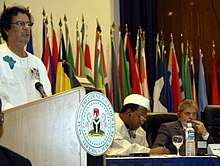
In Africa
- Organisation of African Unity, succeeded by the African Union
- African Unification Front
- Rassemblement Démocratique Africain
- All-African People's Revolutionary Party
- Convention People's Party (Ghana)
- Pan-African Renaissance[47]
- Economic Freedom Fighters (South Africa)
- Pan Africanist Congress of Azania (South Africa)
In the Caribbean
- The Pan-African Affairs Commission for Pan-African Affairs, a unit within the Office of the Prime Minister of Barbados.[48]
- African Society for Cultural Relations with Independent Africa (Guyana)
- Antigua Caribbean Liberation Movement (Antigua and Barbuda)
- Clement Payne Movement (Barbados)
- Marcus Garvey People's Political Party (Jamaica)
- Universal Negro Improvement Association and African Communities League (Jamaica)
In the United Kingdom
In the United States
- The Council on African Affairs (CAA): founded in 1937 by Max Yergan and Paul Robeson, the CAA was the first major U.S. organization whose focus was on providing pertinent and up-to-date information about Pan-Africanism across the United States, particularly to African Americans. Probably the most successful campaign of the Council was for South African famine relief in 1946. The CAA was hopeful that, following World War II, there would be a move towards Third World independence under the trusteeship of the United Nations.[49] To the CAA's dismay, the proposals introduced by the U.S. government to the conference in April/May 1945 set no clear limits on the duration of colonialism and no motions towards allowing territorial possessions to move towards self-government.[49] Liberal supporters abandoned the CAA, and the federal government cracked down on its operations. In 1953 the CAA was charged with subversion under the McCarran Internal Security Act. Its principal leaders, including Robeson, W. E. B. Du Bois, and Alphaeus Hunton (1903–70), were subjected to harassment, indictments, and in the case of Hunton, imprisonment. Under the weight of internal disputes, government repression, and financial hardships, the Council on African Affairs disbanded in 1955.[50]
- The US Organization was founded in 1965 by Maulana Karenga, following the Watts riots. It is based on the synthetic African philosophy of kawaii, and is perhaps best known for creating Kwanzaa and the Nguzo Saba ("seven principles"). In the words of its founder and chair, Karenga, "the essential task of our organization Us has been and remains to provide a philosophy, a set of principles and a program which inspires a personal and social practice that not only satisfies human need but transforms people in the process, making them self-conscious agents of their own life and liberation".[51]
Pan-African concepts and philosophies
Afrocentric pan-Africanism
Afrocentric pan-Africanism is espoused by Kwabena Faheem Ashanti in his book The Psychotechnology of Brainwashing: Crucifying Willie Lynch. Another newer movement that has evolved from the early Afrocentric school is the Afrisecal movement or Afrisecaism of Francis Ohanyido, a Nigerian philosopher-poet.[52] Black nationalism is sometimes associated with this form of pan-Africanism.
Kawaida
Hip hop
Since the late 1970s, hip hop has emerged as a powerful force that has partly shaped black identity worldwide. In his 2005 article "Hip-hop Turns 30: Whatcha Celebratin' For?", Greg Tate describes hip-hop culture as the product of a Pan-African state of mind. It is an "ethnic enclave/empowerment zone that has served as a foothold for the poorest among us to get a grip on the land of the prosperous".[53] Hip-hop unifies those of African descent globally in its movement towards greater economic, social and political power. Andreana Clay in her article "Keepin' it Real: Black Youth, Hip-Hop Culture, and Black Identity" states that hip-hop provides the world with "vivid illustrations of Black lived experience", creating bonds of black identity across the globe.[54] From a Pan-African perspective, hip-hop culture can be a conduit to authenticate a black identity, and in doing so, creates a unifying and uplifting force among Africans that Pan-Africanism sets out to achieve.
Pan-African art
See also
- African Diaspora
- African nationalism
- Africana womanism
- Afro-pessimism
- Black nationalism
- First Pan-African Conference
- Les Afriques
- List of topics related to Black and African people
- Négritude
- Nigerian nationalism
- Pan African Writers' Association
- Pan-African Congress
- Pan-African Federation
- Pan-African Parliament
- Pan-nationalism
- TransAfrica
- World Festival of Black Arts
- La Raza
- Panhispanism
References
- Austin, David (Fall 2007). "All Roads Led to Montreal: Black Power, the Caribbean and the Black Radical Tradition in Canada". Journal of African American History. 92 (4): 516–539. doi:10.1086/JAAHv92n4p516.
- Oloruntoba-Oju, Omotayo (December 2012). "Pan Africanism, Myth and History in African and Caribbean Drama". Journal of Pan African Studies. 5 (8): 190 ff.
- Tajudeen Abdul-Raheem Pan Africanism: Politics, Economy and Social Change in the Twenty-first Century.
- Frick, Janari, et al. (2006), History: Learner's Book, p. 235, South Africa: New Africa Books.
- Makalani, Minkah (2011), "Pan-Africanism". Africana Age.
- New Dictionary of the History of Ideas. The Gale Group, Inc. 2005.
- About the African Union Archived January 29, 2011, at the Wayback Machine.
- "Pan-Africanism". Encyclopedia Britannica. Retrieved May 24, 2020.
- "The objectives of the PAP", The Pan-African Parliament – 2014 and beyond.
- Falola, Toyin; Essien, Kwame (2013). Pan-Africanism, and the Politics of African Citizenship and Identity. London: Routledge. pp. 71–72. ISBN 978-1135005191. Retrieved September 26, 2015.
- Goebel, Anti-Imperial Metropolis, pp. 250–278.
- Maguire, K., "Ghana re-evaluates Nkrumah", GlobalPost, October 21, 2009. Retrieved September 13, 2012.
- Clarke, John Henrik (1988). "Pan-Africanism: A Brief History of An Idea in the African World". Présence Africaine. Editions Présence Africaine (145): 26–56. doi:10.3917/presa.145.0026. JSTOR 24351577.
- Agyeman, O., Pan-Africanism and Its Detractors: A Response to Harvard's Race Effacing Universalists, Harvard University Press (1998), cited in Mawere, Munyaradzi; Tapuwa R. Mubaya, African Philosophy and Thought Systems: A Search for a Culture and Philosophy of Belonging, Langaa RPCIG (2016), p. 89. ISBN 9789956763016. Retrieved August 23, 2018.
- "Pan-Africanism". exhibitions.nypl.org. Retrieved February 16, 2017.
- "A history of Pan-Africanism", New Internationalist, 326, August 2000.
- The History of Pan Africanism, PADEAP (Pan African Development Education and Advocacy Programme).
- Lubin, Alex, "The Contingencies of Pan-Africanism", Geographies of Liberation: The Making of an Afro-Arab Political Imaginary, Chapel Hill: University of North Carolina Press, 2014, p. 71.
- Smith-Asante, E., "Biography of Ghana’s first President, Dr Kwame Nkrumah", Graphic Online, March 8, 2016. Retrieved March 23, 2017.
- Mkandawire, P. (2005). African Intellectuals: Rethinking Politics, Language, Gender and Development, Dakar: Codesria/London: Zed Books, p. 58. Retrieved March 23, 2017.
- Legum, C. (1965). Pan-Africanism: a short political guide, New York, etc.: Frederick A. Praeger, p. 41.
- Adi, H., & M. Sherwood (2003). Pan-African History: Political Figures from Africa and the Diaspora Since 1787, London: Routledge, p. 66.
- Legum (1965). Pan-Africanism, p. 42.
- Adi & Sherwood (2003). Pan-African History, p. 179.
- Legum (1965), Pan-Africanism, p. 45.
- Legum (1965). Pan-Africanism, p. 46.
- Legum (1965), Pan-Africanism, p. 47.
- Martin, G. (2012). African Political Thought, New York: Palgrave Macmillan.
- Adi & Sherwood (2003), Pan-African History, p. 10.
- "African states unite against the white rule", ON THIS DAY | May 25. BBC News. Retrieved March 23, 2017.
- Evans, M., & J. Phillips (2008). Algeria: Anger of the Dispossessed, Yale University Press, pp. 97–98.
- Martin, G. (December 23, 2012). African Political Thought. Springer. ISBN 9781137062055.
- See e.g. Ronald W. Walters, Pan Africanism in the African Diaspora: An Analysis of Modern Afrocentric Political Movements, African American Life Series, Wayne State University Press, 1997, p. 68.
- Turner, R. B. (1997). Edward Wilmot Blyden and pan-Africanism: the ideological roots of Islam and Black nationalism in the United States. Muslim World, 87, 169–182.
- Campbell, Crystal Z. (December 2006). "Sculpting a Pan-African Culture in the Art of Négritude: A Model for African Artist" (PDF). The Journal of Pan African Studies. 1 (6). Archived from the original on June 1, 2015.CS1 maint: BOT: original-url status unknown (link)
- Oxford University African Society Conference, Corpus Christi College, Oxford University, May 5, 2012.
- "About Us". Csus.edu. Retrieved October 15, 2015.
- The M.A. in Pan African Studies Archived October 25, 2014, at the Wayback Machine, African American Studies at Syracuse University.
- Smith, Whitney (2001). Flag Lore of All Nations. Millbrook Press. p. 36. ISBN 0761317538. Retrieved October 7, 2014.
- Lionel K., McPherson; Shelby, Tommie (Spring 2004). "Blackness and Blood: Interpreting African American Identity" (PDF). Philosophy and Public Affairs. 32 (2): 171–192. doi:10.1111/j.1088-4963.2004.00010.x.
- Wikisource contributors, "The Declaration of the Rights of the Negro Peoples of the World", Wikisource, The Free Library. (Retrieved October 6, 2007).
- "25,000 Negroes Convene International Gathering Will Prepare Own Bill of Rights", The New York Times, August 2, 1920. Proquest. Retrieved October 5, 2007.
- "Negroes Adopt Bill Of Rights: Convention Approves Plan for the African Republic and Sets to Work on Preparation of Constitution of the Colored Race Negro Complaints Aggression Condemned Recognition Demanded". The Christian Science Monitor, August 17, 1920. Proquest. Retrieved October 5, 2007.
- "What Holocaust". Glenn Reitz. Archived from the original on October 18, 2007.
- "The Maafa, African Holocaust". Swagga. Archived from the original on 2007-02-08. Retrieved 2007-01-28.
- Ogunleye, Tolagbe (1997). "African American Folklore: Its Role in Reconstructing African American History". Journal of Black Studies. 27 (4): 435–455. doi:10.1177/002193479702700401. ISSN 0021-9347. JSTOR 2784725.
- "Pan-African Renaissance".
- Worrell, Rodney (2005). Pan-Africanism in Barbados: An Analysis of the Activities of the Major 20th-century Pan-African Formations in Barbados. New Academia Publishing, LLC. pp. 99–102. ISBN 978-0-9744934-6-6.
- Duberman, Martin. Paul Robeson, 1989, pp. 296–97.
- "Council on African Affairs", African Activist Archive.
- "Philosophy, Principles, and Program". The Organization Us.
- "Francis Okechukwu Ohanyido". African Resource. October 7, 2006.
- Tate, Greg, "Hip-hop Turns 30: Whatcha Celebratin' For?", Village Voice, January 4, 2005.
- Clay, Andreana. "Keepin' it Real: Black Youth, Hip-Hop Culture, and Black Identity". In American Behavioral Scientist, Vol. 46.10 (2003): 1346–58.
Further reading
- Hakim Adi, Pan-Africanism: A History. London: Bloomsbury, 2018.
- Hakim Adi & Marika Sherwood, Pan-African History: Political Figures from Africa and the Diaspora Since 1787, London: Routledgem 2003.
- Imanuel Geiss, Panafrikanismus. Zur Geschichte der Dekolonisation. Habilitation, EVA, Frankfurt am Main, 1968, English as: The Pan-African Movement, London: Methuen, 1974, ISBN 0-416-16710-1, and as: The Pan-African Movement. A history of Pan-Africanism in America, Europe and Africa, New York: Africana Publ., 1974, ISBN 0-8419-0161-9.
- Colin Legum, Pan-Africanism: A Short Political Guide, revised edition, New York: Frederick A. Praeger, 1965.
- Tony Martin, Pan-African Connection: From Slavery to Garvey and Beyond, Dover: The Majority Press, 1985.
External links
- SNCC Digital Gateway: Pan-Africanism—Digital documentary website created by the SNCC Legacy Project and Duke University, telling the story of the Student Nonviolent Coordinating Committee & grassroots organizing from the inside-out
- African Union
- African Code Unity Through Diversity
- A-APRP Website
- The Major Pan-African news and articles site
- Professor David Murphy (November 15, 2015). "The Performance of Pan-Africanism: performing black identity at major pan-African festivals, 1966–2010" (Podcast). The University of Edinburgh. Retrieved January 28, 2016 – via Soundcloud.
